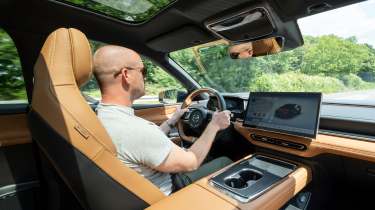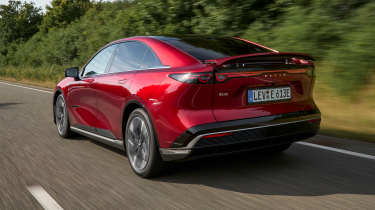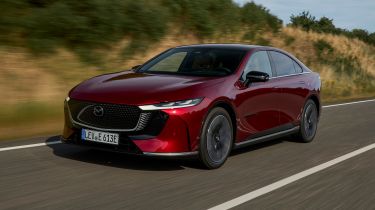New Mazda 6e 2025 review: a fine family EV but there's a catch
There's a lot to like about the new 6e, but it's missing some crucial Mazda touches
Verdict
Viewed purely as an electric family-car newcomer, there are plenty of things to like about the 6e. Refinement is superb, fit and finish is impressive and the cabin is fairly spacious. However, it doesn’t feel like a Mazda when two of the brand's key qualities – ergonomics and beautiful feel and feedback through the driving controls – are missing. Feeling like a Mazda was always a good reason to choose one over any of its other rivals - without that, the 6e seems like it’s lacking a USP.
This is the all-new Mazda 6e that replaces a car which, try as we did to sing its praises, never really seemed to achieve the success it deserved.
The third-generation Mazda 6 arrived in 2012 and offered buyers a smart-looking, spacious and brilliant-to-drive alternative to the Ford Mondeo, Vauxhall Insignia and Skoda Superb. While the first two have since fallen by the wayside and the Superb continues with the same formula that has worked so well for it, the ‘e’ in the 6 name shows that for this model, Mazda has taken its large family car into the electric era.
That puts a new wave of rivals in its sights. While the first car that’ll spring to mind for many is the Tesla Model 3, the 6e is bigger. At more than 4.9 metres long, the closest challenger size-wise is what we consider to be VW's most convincing EV yet, the Volkswagen ID.7.
Used - available now

2022 BMW
3 Series Touring
67,810 milesAutomaticPetrol2.0L
Cash £15,039
2023 BMW
5 Series
45,530 milesAutomaticDiesel2.0L
Cash £26,300
2024 Volkswagen
Golf
31,470 milesManualPetrol1.0L
Cash £15,497
2023 Ford
Kuga
13,273 milesAutomaticPetrol2.5L
Cash £21,799That size certainly lends the 6e plenty of presence, and with the large grille flanked by glowing elements and the rear lights, which Mazda says reference the full-width panel of the beautiful RX-7, it does stand out from the competition. All models ride on 19-inch wheels, and there are eight colours to choose from, plus three more inside.
But it’s in the cabin where some things start to feel rather un-Mazda. The Japanese brand has long resisted the march of the touchscreen and remained a champion of physical controls. Even where touchscreens have been fitted in its models, these tend to only work when the car is parked; on the move you’d need to twiddle the firm’s BMW iDrive-style clickwheel to make adjustments. But in a U-turn as rapid as an Mazda MX-5 at an autotest (but less fun to see), Mazda has ditched its approach completely here, and goes in hard with a huge touchscreen.
Beyond the window switches, pretty much everything else goes through the 14.6-inch display. While there is plenty of customisation for shortcuts, we feel that with so many features needing more than one motion – be it pressing or swiping or both on the display – it’s a step back from a simple twiddle of a temperature dial or pressing a light switch.

Yes, that’s right; even the lights and wipers can only be controlled through the screen. There are two customisable shortcut buttons on the steering wheel that could be assigned to these if necessary, but we can’t see why there isn’t a dedicated switch for each, leaving the shortcut open to other useful functions, such as turning off the slightly forceful lane-keep assist system.
This will be a shame to Mazda fans, especially because elsewhere, the cabin design is really pleasant. The materials in our top-spec Takumi Plus feel as sumptuous as we’ve come to expect from Mazda, and the level of finish is closer to premium EVs like the BMW i4 than the Hyundai Ioniq 6, Tesla Model 3 and Volkswagen ID.7.
There are some practicality quirks elsewhere, though. The shallow angle of the boot makes the rear window so small that it’s as good as pointless trying to use the rear-view mirror. Rear-seat passengers get huge knee room and a wide rear bench, but the floor level is quite high relative to the seat base, so taller occupants will not find the space as useful as it looks at first glance.
Mazda quotes a boot volume of 330 litres, but we’re not sure how it has arrived at such a small figure; it doesn’t quite appear to be on the ID.7’s 532-litre level, but it looks significantly larger than the official number suggests. The hatchback opening makes the space very easy to access, plus there’s the added bonus of a generous 72-litre ‘frunk’, too.
Mazdas have always had a very distinctive feeling on the road. In a market where many manufacturers have given up on the simple things that make a car fun to drive at any speed – feel, feedback and well matched control weights – everything from the MX-5 to a Mazda CX-30 SUV still give responses that a keen driver will appreciate. Unfortunately, much like the touchscreen, Mazda seems to have changed its approach here.

It’s not to say that the 6e is a bad car to drive, because there are some areas where it’s very impressive. A superbly hushed cabin is the highlight, while limited body roll and a neat balance front to rear (Mazda states a 47:53 weight distribution) make it more competent through corners than most of its rivals.
But there isn’t that distinct “Mazdaness” here. The steering’s quick rack does a decent job of masking the car’s mass, but it feels artificial; it’s telling that there are two steering weight settings, when most other Mazdas just have one that feels right from the outset. On the German roads close to Mazda’s European HQ near Leverkusen, we found the low-speed ride a little fidgety, but it was more compliant than a Mazda CX-60 we also spent some time in.
There is also oddness to consider when it comes to the powertrains. Buyers have two to choose from; both use a single motor driving the rear wheels, and both have 310Nm, but one produces 254bhp and the other 241bhp. Curiously, the more potent unit comes with the smaller battery choice – 68.8kWh and 80kWh units are offered. Due to the different chemistries in each, both packs weigh 480kg, with the larger one offering a longer official WLPT range: 342 miles versus 298 miles.
More strange than any of that, though, is that the long-range model gets a maximum 90kW charge speed – slower than many electric city cars. That’s well below the 68.8kWh battery’s 165kW capability – a figure that’s not class-leading, but at least reasonable.
We sampled the smaller of the two battery options. Performance feels lively from a standstill, making you initially think the 7.6-second 0-62mph time is pessimistic. However, acceleration does tail off a little more as the speed increases.
It’s also possible to adjust the brake regen levels through four options. However, these can only be accessed through the touchscreen (not via steering wheel paddles, as we prefer) and only in the Individual mode can the driver select their preferred setting. In Normal and Sport modes, the regen level can’t be adjusted.
There is one more issue, and it’s that UK buyers will have to wait. While European models go on sale this September, we won’t be getting right-hand drive cars until the first half of 2026. But if European prices are anything to go by, the 6e could offer tempting value – we’re predicting UK figures of between £45,000 and £50,000, depending on trim and battery. Equipment levels look to be strong, with the likes of ventilated wireless smartphone charging, a dual sunroof, a Sony audio system with speaker headrests that can be used for private hands-free calling, rear cross-traffic alert, blind spot monitoring and vehicle-to-load tech all available.
| Model: | Mazda 6e |
| Price from | £45,000 (est) |
| Powertrain: | 68.8kWh battery, 1x e-motor |
| Power/torque: | 254bhp/310Nm |
| Transmission: | Single-speed, rear-wheel drive |
| 0-62mph: | 7.6 seconds |
| Top speed: | 105mph |
| Range: | 298 miles |
| Charging: | 165kW (10-80% in 24 mins) |
| Dimensions (L/W/H): | 4,921/1,890/1,491mm |
| On sale: | Early/mid 2026 |
Can't wait for the 6e's arrival? Take a look at these great Mazda deals...
Deals on the Mazda 6e's key rivals

